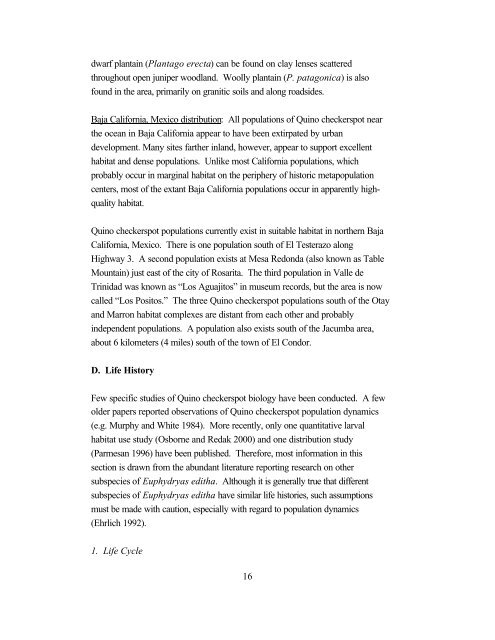Outline of Quino Recovery Plan - The Xerces Society
Outline of Quino Recovery Plan - The Xerces Society
Outline of Quino Recovery Plan - The Xerces Society
Create successful ePaper yourself
Turn your PDF publications into a flip-book with our unique Google optimized e-Paper software.
dwarf plantain (<strong>Plan</strong>tago erecta) can be found on clay lenses scattered<br />
throughout open juniper woodland. Woolly plantain (P. patagonica) is also<br />
found in the area, primarily on granitic soils and along roadsides.<br />
Baja California, Mexico distribution: All populations <strong>of</strong> <strong>Quino</strong> checkerspot near<br />
the ocean in Baja California appear to have been extirpated by urban<br />
development. Many sites farther inland, however, appear to support excellent<br />
habitat and dense populations. Unlike most California populations, which<br />
probably occur in marginal habitat on the periphery <strong>of</strong> historic metapopulation<br />
centers, most <strong>of</strong> the extant Baja California populations occur in apparently highquality<br />
habitat.<br />
<strong>Quino</strong> checkerspot populations currently exist in suitable habitat in northern Baja<br />
California, Mexico. <strong>The</strong>re is one population south <strong>of</strong> El Testerazo along<br />
Highway 3. A second population exists at Mesa Redonda (also known as Table<br />
Mountain) just east <strong>of</strong> the city <strong>of</strong> Rosarita. <strong>The</strong> third population in Valle de<br />
Trinidad was known as “Los Aguajitos” in museum records, but the area is now<br />
called “Los Positos.” <strong>The</strong> three <strong>Quino</strong> checkerspot populations south <strong>of</strong> the Otay<br />
and Marron habitat complexes are distant from each other and probably<br />
independent populations. A population also exists south <strong>of</strong> the Jacumba area,<br />
about 6 kilometers (4 miles) south <strong>of</strong> the town <strong>of</strong> El Condor.<br />
D. Life History<br />
Few specific studies <strong>of</strong> <strong>Quino</strong> checkerspot biology have been conducted. A few<br />
older papers reported observations <strong>of</strong> <strong>Quino</strong> checkerspot population dynamics<br />
(e.g. Murphy and White 1984). More recently, only one quantitative larval<br />
habitat use study (Osborne and Redak 2000) and one distribution study<br />
(Parmesan 1996) have been published. <strong>The</strong>refore, most information in this<br />
section is drawn from the abundant literature reporting research on other<br />
subspecies <strong>of</strong> Euphydryas editha. Although it is generally true that different<br />
subspecies <strong>of</strong> Euphydryas editha have similar life histories, such assumptions<br />
must be made with caution, especially with regard to population dynamics<br />
(Ehrlich 1992).<br />
1. Life Cycle<br />
16
















